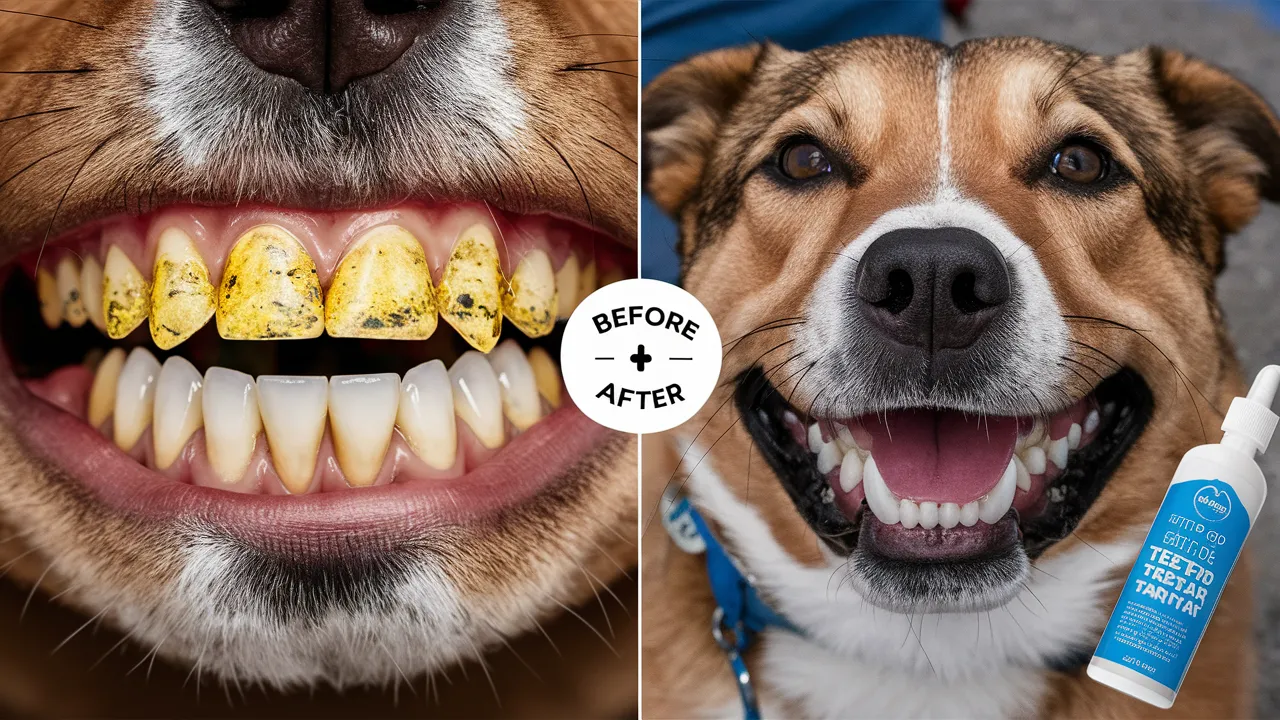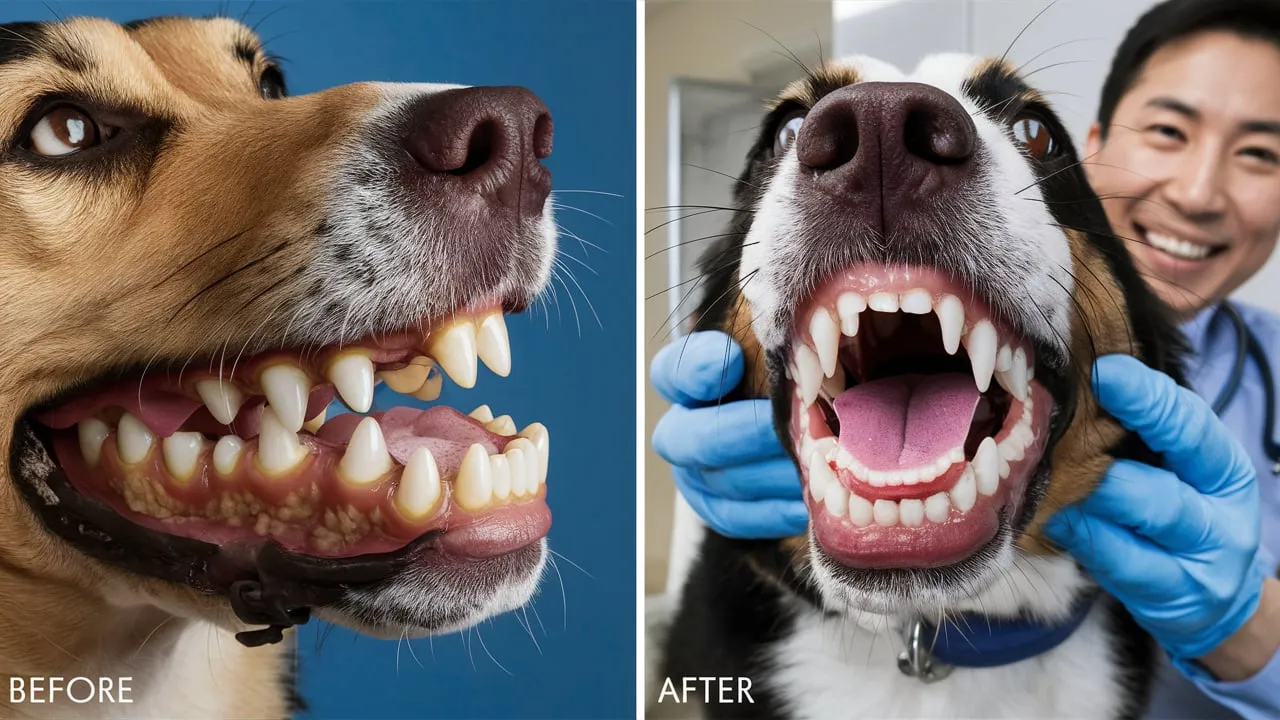How to Get Rid of Dog Tartar? Tartar buildup on your dog’s teeth can lead to serious health problems if not addressed.
In this comprehensive guide, Dogs Infor will explore effective ways to remove tartar from your dog’s teeth and preventive measures to ensure your dog’s dental health remains in top shape.
What is Dog Tartar?
The Science Behind Tartar Buildup
This section should explain the process of how tartar forms on a dog’s teeth:
- Bacteria and Plaque: Start by explaining how bacteria in the mouth constantly form plaque, a sticky film that adheres to teeth.
- Mineralization: Describe how saliva contains minerals like calcium and phosphate. These minerals bind to plaque, causing it to harden into tartar.
- The Cycle of Tartar: Explain how tartar creates a rough surface that attracts even more bacteria, perpetuating the cycle of plaque and tartar buildup.
The Dangers of Tartar
This section should highlight the negative consequences of tartar buildup:
- Gum Inflammation: Explain how tartar irritates the gums, leading to gingivitis, the first stage of periodontal disease.
Gum Recession: Describe how tartar buildup can cause the gums to recede, exposing the tooth roots and creating pockets where bacteria can thrive.
Bone Loss: Explain how bacteria in these pockets can damage the bone that supports the teeth, leading to tooth loosening and eventual loss.
Bad Breath: Mention how tartar is a major contributor to bad breath in dogs.
Systemic Health Risks: Explain how bacteria from infected gums can enter the bloodstream, potentially affecting other organs and increasing the risk of heart disease, kidney disease, and other health problems.

Signs of Tartar Buildup
Early Signs
- Yellow or brown stains: These are the first visible signs of tartar buildup. They may appear on the gum line or along the tooth surface.
- Rough texture: Run your finger gently along your dog’s teeth. If you feel a rough or gritty texture, it could indicate tartar buildup.
- Bad breath: Tartar buildup can cause bad breath, even if your dog’s teeth are otherwise clean.
Advanced Signs
- Visible tartar buildup: Tartar may become more prominent and spread to more teeth.
- Receding gums: Tartar can irritate the gums, causing them to recede and create pockets between the teeth and gums.
- Red, swollen, or bleeding gums: These are signs of gingivitis, the first stage of periodontal disease.
- Loose teeth: Advanced tartar buildup can damage the bone that supports the teeth, leading to looseness and eventual tooth loss.
How to Get Rid of Dog Tartar
Tartar, also known as calculus, is hardened plaque that can’t be removed by brushing alone. It’s a major contributor to periodontal disease, so it’s essential to address it. Here’s how to get rid of dog tartar:
Professional Dental Cleaning
- The Gold Standard: This is the most effective way to remove tartar.
- Procedure: Your veterinarian will perform a thorough cleaning under anesthesia, using specialized tools to scrape off tartar and plaque.
- Frequency: Your veterinarian will recommend the appropriate frequency based on your dog’s individual needs, but most dogs need professional cleanings at least once a year.
At-Home Brushing
- Prevention is Key: While brushing won’t remove existing tartar, it can help prevent further buildup.
- Technique: Use a dog-specific toothbrush and toothpaste and brush your dog’s teeth daily.
- Limitations: Brushing alone won’t remove hardened tartar, but it’s a crucial part of overall dental hygiene.
Dental Chews and Treats
- Limited Effectiveness: While some dental chews and treats can help reduce plaque buildup, they are not effective at removing existing tartar.
- VOHC Seal: Look for products with the Veterinary Oral Health Council (VOHC) seal of approval for effectiveness.
Dental Water Additives
- Limited Effectiveness: Dental water additives can help reduce plaque buildup, but they are not effective at removing existing tartar.
- Consult Your Vet: Discuss the use of dental water additives with your veterinarian.
Home Remedies
- Avoid: There are many home remedies circulating online, but these are not recommended as they can be ineffective and potentially harmful to your dog.

Preventing Tartar Buildup
Tartar buildup is the precursor to periodontal disease, so preventing it is crucial for your dog’s dental health. Here are some effective strategies:
Daily Dental Care Routines
- Brushing: The most effective way to prevent tartar buildup is by brushing your dog’s teeth daily. Use a dog-specific toothbrush and toothpaste and gently brush the outer, inner, and chewing surfaces of each tooth. Start with short sessions and gradually increase the duration as your dog becomes accustomed to it.
- Dental Wipes: If brushing is difficult, dental wipes can be a helpful alternative. They can help remove food particles and plaque, but they are not as effective as brushing.
Dental Chews and Toys
- VOHC Seal: Look for dental chews and toys that have the Veterinary Oral Health Council (VOHC) seal of approval, indicating they have been scientifically proven to reduce plaque and tartar buildup.
- Variety: Offer a variety of textures and shapes to keep your dog engaged and encourage chewing.
- Supervision: Always supervise your dog when they are chewing on dental toys, especially those made of rawhide, to prevent choking or ingestion.
Dental Water Additives
- Enzymes: These additives contain enzymes that break down plaque and tartar.
- Effectiveness: The effectiveness of dental water additives varies, and they are not a substitute for brushing.
- Consult Your Vet: Discuss the use of dental water additives with your veterinarian to determine if they are appropriate for your dog.
By incorporating these preventative measures into your dog’s routine, you can significantly reduce the risk of tartar buildup and help them maintain a healthy smile throughout their life.
Conclusion
Maintaining your dog’s dental health is crucial for their overall well-being. By incorporating regular brushing, dental chews, professional cleanings, and other preventive measures into your routine, you can keep tartar at bay and ensure your dog has a healthy, happy smile. Remember, a little effort each day can prevent serious dental problems down the line.

Related Post
How Tight Should A Dog’s Collar Be? How To Determine
Dog Crying At Night: Understanding And Solving The Problem
Puppy Teething Age Chart: Stages, Symptoms